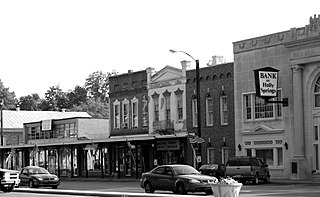Related Research Articles

John James Audubon was an American self-trained artist, naturalist, and ornithologist. His combined interests in art and ornithology turned into a plan to make a complete pictorial record of all the bird species of North America. He was notable for his extensive studies documenting all types of American birds and for his detailed illustrations, which depicted the birds in their natural habitats. His major work, a color-plate book titled The Birds of America (1827–1839), is considered one of the finest ornithological works ever completed. Audubon is also known for identifying 25 new species. He is the eponym of the National Audubon Society, and his name adorns a large number of towns, neighborhoods, and streets in every part of the United States. Dozens of scientific names first published by Audubon are currently in use by the scientific community.

Alton is a city on the Mississippi River in Madison County, Illinois, United States, about 18 miles (29 km) north of St. Louis, Missouri. The population was 25,676 at the 2020 census. It is a part of the Metro-East region of the Greater St. Louis metropolitan area. It is famous for its limestone bluffs along the river north of the city, and for its role preceding and during the American Civil War. It was the site of the last Abraham Lincoln and Stephen Douglas debate in October 1858. The former state penitentiary in Alton was used during the Civil War to hold up to 12,000 Confederate prisoners of war.

Holly Springs is a city in and the county seat of Marshall County, Mississippi, United States, at the southern border of Tennessee. Near the Mississippi Delta, the area was developed by European Americans for cotton plantations and was dependent on enslaved Africans. After the American Civil War, many freedmen continued to work in agriculture as sharecroppers and tenant farmers.

Holly Springs is a town in Wake County, North Carolina, United States. As of the 2020 census, the town population was 41,239, a 67% increase from 2010.

Varina Anne Banks Howell Davis was the only First Lady of the Confederate States of America, and the longtime second wife of President Jefferson Davis. She moved to a house in Richmond, Virginia, in mid-1861, and lived there for the remainder of the American Civil War. Born and raised in the South and educated in Philadelphia, she had family on both sides of the conflict and unconventional views for a woman in her public role. She did not support the Confederacy's position on slavery, and was ambivalent about the war.

The National Audubon Society is an American non-profit environmental organization dedicated to conservation of birds and their habitats. Located in the United States and incorporated in 1905, Audubon is one of the oldest of such organizations in the world. There are completely independent Audubon Societies in the United States, which were founded several years earlier such as the Massachusetts Audubon Society and Connecticut Audubon Society.

The Rock Island Arsenal comprises 946 acres (383 ha), located on Arsenal Island, originally known as Rock Island, on the Mississippi River between the cities of Davenport, Iowa, and Rock Island, Illinois. It lies within the state of Illinois. Rock Island was previously used as the summer camp site for Sauk Native Americans, and the dispute over tribal ownership led to the Black Hawk War of 1832, after the primary leader of the Sauk, Black Hawk. It is now home of First Army headquarters, and the US Army's Center of Excellence for Additive Manufacturing. The island was originally established as a government site in 1816, with the building of Fort Armstrong. It is now the largest government-owned weapons manufacturing arsenal in the United States. It has manufactured military equipment and ordnance since the 1880s. In 1919–1920 one hundred of the Anglo-American or Liberty Mark VIII tanks were manufactured, although too late for World War I. It is designated as a National Historic Landmark.
The American Battlefield Trust is a charitable organization whose primary focus is in the preservation of battlefields of the American Civil War, the Revolutionary War and the War of 1812 through acquisition of battlefield land. The American Battlefield Trust was formerly known as the Civil War Trust. On May 8, 2018, the organization announced the creation of the American Battlefield Trust as the umbrella organization for two divisions, the Civil War Trust and the Revolutionary War Trust, which was formerly known as "Campaign 1776."

Varina is a former unincorporated community and current magisterial district in the easternmost portion of Henrico County, Virginia, United States.

Richardson Bay is a shallow, ecologically rich arm of San Francisco Bay, managed under a Joint Powers Agency of four northern California cities. The 911-acre (369 ha) Richardson Bay Sanctuary was acquired in the early 1960s by the National Audubon Society. The bay was named for William A. Richardson, early 19th century sea captain and builder in San Francisco. It contains both Strawberry Spit and Aramburu Island.

Coldwater Spring is a spring in the Fort Snelling unorganized territory of the U.S. state of Minnesota, that is considered a sacred site by the Dakota people, and was also the site of the U.S. Army's Camp Coldwater for troops that constructed Fort Snelling. Coldwater Spring is located on the west bluffs of the Mississippi River directly south of Minnehaha Park and adjacent to Fort Snelling State Park. Waters from the naturally occurring spring flow continuously year round and remain unfrozen in winter months. The spring and surrounding area is managed as a protected historic site and natural park by the National Park Service as part of the Mississippi National River and Recreation Area.

Finly Hutchinson Gray was an American lawyer and politician who served two separate three-term stints as a U.S. Representative from Indiana in the early 20th Century.

The Lyford House is a Victorian house located in Tiburon, California. Built in 1876, the house is listed on the National Register of Historic Places.

Mississippi Industrial College was a historically black college in Holly Springs, Mississippi. It was founded in 1905 by the Mississippi Conference of the Colored Methodist Episcopal Church. After desegregation of community colleges in the mid-20th century, it had trouble competing and eventually closed in 1982. The campus was listed as a historic site on the National Register of Historic Places in 1980 and was acquired by Rust College in 2008.
The Holly Springs Female Institute was an early female seminary for white women, founded in Holly Springs, Mississippi in 1836.

Mount Holly was a historic Southern plantation in Foote, Mississippi. Built in 1855, it was visited by many prominent guests, including Confederate President Jefferson Davis. It was later acquired by ancestors of famed Civil War novelist Shelby Foote, who wrote a novel about it. It burned down on June 17, 2015.
Lycurgus Johnson (1818-1876) was an American cotton planter and large slaveholder in the Arkansas Delta during the antebellum years. Born to the powerful political and planter Johnson family in Scott County, Kentucky, he became the owner and developer of the Lakeport Plantation in Chicot County, Arkansas. It bordered the west bank of the Mississippi River.

Spires Boling (1812–1880), whose name is often misspelled as Spires Bolling, was a slaveowner, master builder, architect, and distillery founder in Holly Springs, Mississippi. He is known for holding the journalist Ida B. Wells and her family in bondage. There is now a museum dedicated to her in his former home the Boling–Gatewood House. He is also remembered for his grand, columned, neoclassical residential buildings and his design for the Marshall County, Mississippi Courthouse in Holly Springs. His courthouse design was also used by the firm of Willis, Sloan, and Trigg for two other courthouses and featured in the work of William Faulkner. The Walter Place mansion he designed was home to Ulysses S. Grant and his wife for a period during the American Civil War.
References
- 1 2 "Strawberry Plains Audubon Center" – via www.upress.state.ms.us.
- ↑ "About Us". Strawberry Plains Audubon Center. December 22, 2015.
- ↑ Parsons, Ginna. "Strawberry Plains readies for annual invasion of hummingbirds". Daily Journal. Retrieved 12 January 2020.
- ↑ "Strawberry Plains Audubon Center". The Jackson Sun.
- ↑ "You may hear more than bird calls at Strawberry Plains | Today in Mississippi | Mississippi Seen". www.todayinmississippi.com.